We Took On The Difficult Task Of Ranking Hayao Miyazaki Movies (original) (raw)
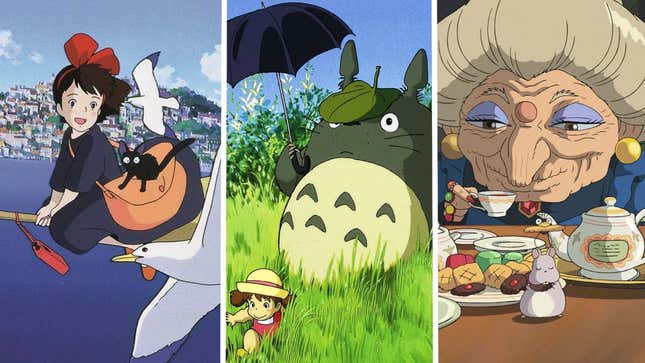
Image: Toei Company / Disney / Toho Ltd.
Hayao Miyazaki is a legendary director and animator whose entire filmography is exceptional, so ranking his films is no easy feat. You’d be hard-pressed to find a “bad” film from the Studio Ghibli co-founder, so this piece is more about ranking from great to masterpiece rather than from good to bad. Miyazaki’s meticulously crafted, hand-drawn animations are colorful and imaginative spectacles with strong female characters, fascinating fantasy creatures, and strong takes on environmental justice.
Hayao Miyazaki’s films may be animated, but they explore mature coming-of-age themes such as developing compassion, individuality, strength, and independence. There’s a deep and thought-provoking wisdom beneath his exciting adventures and magical worlds, which makes his films resonate with audiences of all ages. Read on to see how I ranked each of Hayao Miyazaki’s masterpieces, and see if you agree.

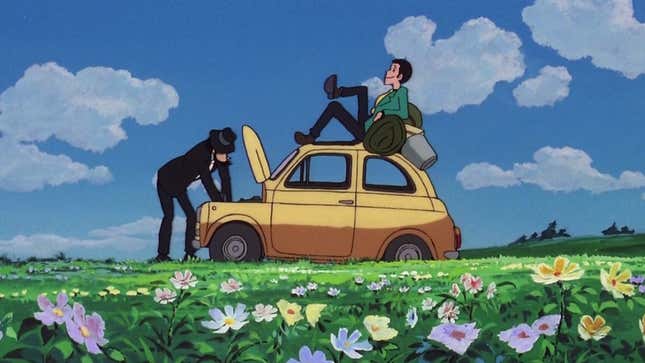
Image: Toho Co., Ltd / Columbia Pictures
It’s unfair to compare Castle of Cagliostro to Hayao Miyazaki’s other films because it was not only his feature film debut but also part of the Lupin III franchise, a popular manga and anime series about legendary thief Arsène Lupin going on daring heists around the world. This time, he wants to rescue Princess Clarisse from being forced to marry a count. This is not one of Miyazaki’s more personal and imaginative stories about environmental justice, coming of age, or resilient female leads, but it does have some enjoyable broad comedy.
The animation is not as intricate as in his later films, but you can certainly see Miyazaki’s flair for whimsy in the thrilling set pieces such as car chases, clock-tower fights, and villains getting trapped in a castle’s catacombs. Castle of Cagliostro is a romp, and though it doesn’t reach the heights of the rest of Miyazaki’s filmography, it’s exciting to see the kernels of what the legendary director would become known for.
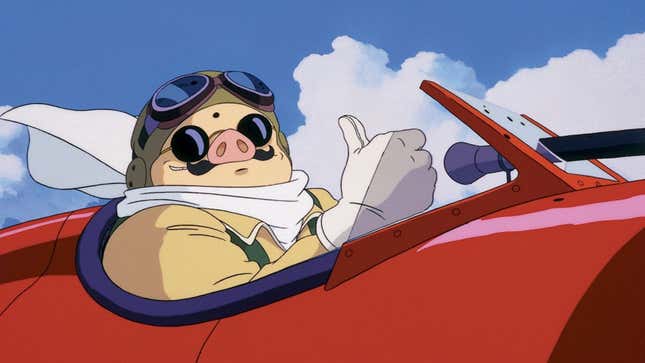
Image: Toho Co., Ltd. / Disney
Porco Rosso is one of Hayao Miyazaki’s silliest films, telling a tale about a World War I fighter pilot who is turned into a pig. With his devil-may-care attitude and salty humor, the various hijinks he gets into are a delight to watch. As with most of Miyazaki’s films, the highlights are invigorating action scenes (in this case, aerial ones) that show off fast-paced, slick animation.
The surly Porco humorously contrasts with the strong-minded female characters like Fio, the plane repairwoman, and Gina, who is in love with him and unfazed by his pig-like appearance, and since Porco exudes so much confidence, her love seems perfectly believable. Porco Rosso is a playful adventure that lightly touches on much deeper themes of wartime trauma and fascism, in ways that only Miyazaki can.
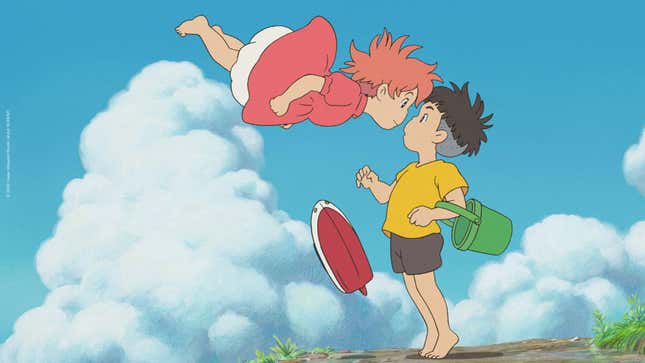
Image: Walt Disney Pictures / Toho Co., Ltd.
Ponyo is one of Hayao Miyazaki’s most light-hearted films and an adaptation of Hans Christen Andersen’s The Little Mermaid. A five-year-old boy named Sosuke discovers a goldfish that wants to be a human little girl—even though this upsets the balance of nature and is against the wishes of her father, a sorcerer who lives in the depths of the ocean. After she gains the ability to become human and chooses to stay on land, a giant tsunami wreaks havoc on Sosuke’s coastal town, satellites fall from the sky, and the moon spins out of orbit.
Despite this, there’s lots of adorable, family-friendly humor to be found in Ponyo’s misunderstanding of life on land, along with quirks like her obsession with ham and the gleeful wiggling of her new toes. The story is thin and predictable, not quite as profound as Hayao Miyazaki’s more original fantasies, but the visuals of Ponyo’s underwater world are truly stunning—the vibrant schools of sea creatures, the amoebas, and the fish-shaped waves that Ponyo skims across are all eye-popping.
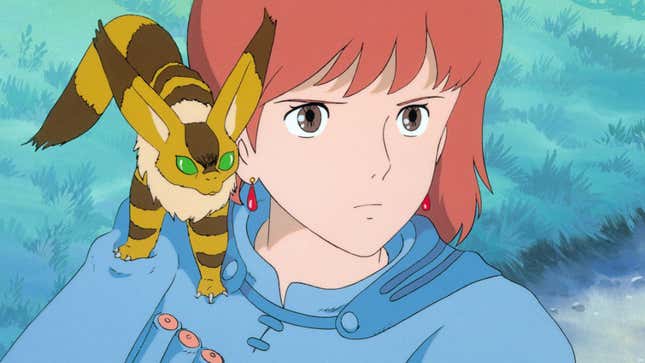
Image: Toei Company / Disney
Nausicaä of the Valley of the Wind is grand in scale and has powerful ecological messages, with a story of two nearby nations at war amidst an environmental wasteland. Nausicaä is the first of many of Miyazaki’s intelligent and brave heroines who must navigate a post-apocalyptic world. Her adventure takes her the Toxic Jungle, a thicket of giant plants, fungi, and huge, creepy-crawly insects, in search of hope and healing.
There’s a lot of visual variety in this film’s landscapes, from the rolling green hills and peaceful windmills of Nausicaä’s country home to ancient, magical ruins and dense, mysterious forests. But the highlights of Nausicaä of the Valley of the Wind are its action-packed flying scenes in which Nausicaä soars swiftly on her glider while warriors maneuver their giant bomber-like planes around her. It’s a rousing journey that is clearly in awe of both the beauty and mystery of nature, reminding us of our duty to protect our planet.
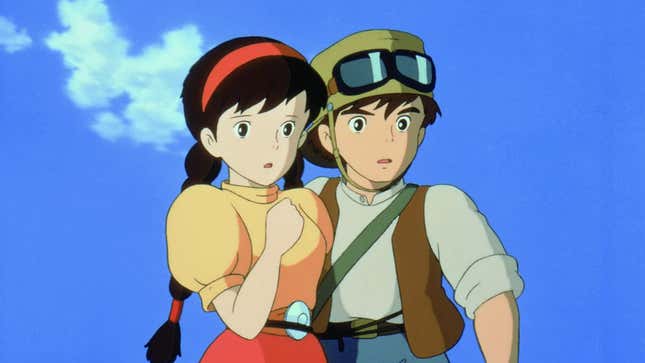
Image: Toei Company
The title itself, Castle in the Sky, brings to mind an otherworldly spectacle, and the film gives us one: Laputa is a magical kingdom hidden amongst puffy clouds and shadows and one of Miyazaki’s most visually stunning settings. The quest young Pazu and Sheeta embark on to reach the titular castle is filled with action, high stakes, and drama. Sheeta and Pazu share a heartwarming friendship that’s tinged with romance—Sheeta is bashful and withdrawn, while Pazu is more lively and exuberant.
Their contrasting personalities make them compelling characters. They are both equally protective of one another; Sheeta bravely wants to finish the mission on her own so that Pazu is not hurt, but he refuses to leave her side. Castle in the Sky also features some of Miyazaki’s most vibrant villains, including an old crone and her quirky group of sky pirate sons and the stoic, deceitful Colonel Muska, who relentlessly pursue Sheeta’s crystal amulet. Castle in the Sky is a soaring fairy tale with a classic good-versus-evil story.
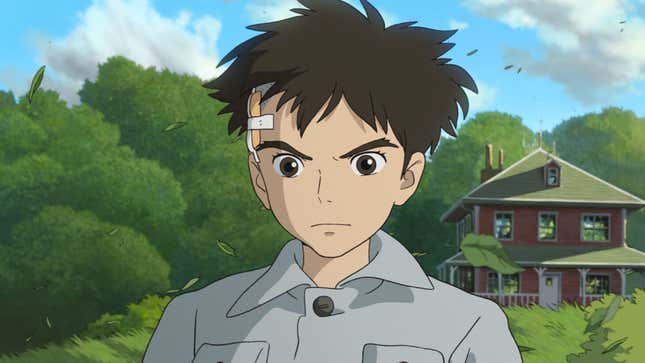
Image: GKIDS / Toho Co., Ltd. / Wild Bunch
Released a decade after his intended retirement, Hayao Miyazaki made The Boy and the Heron at 82 years old. The ambitious film treads familiar territory as a young boy goes on a journey to a brightly colored fantasy world where the living and the dead live in harmony (and there’s also an army of human-like parakeets). Set in 1940s Japan, the film centers 12-year-old Mahito, who has been mourning the death of his mother in a hospital fire after a Tokyo bombing raid by the Allies.
Miyazaki confronts this devastating event in a harrowing flashback sequence, set against a nearly black background, with huge balls of fire raining down on the city—it looks like hell on Earth. Miyazaki uses a hazy, sketch-like animation style to evoke the pain of Mahito’s memory. It’s a very visceral way to confront the audience with the pain and devastation of war, showing how trauma lives inside victims, especially the young ones, forever.
Mahito’s grief allows him to become easily swindled by a mysterious bird, voiced by a gravelly Robert Pattinson, who promises to reunite him with his mother. While The Boy and the Heron explores the ideas of grief, legacy, and family—which feel especially poignant coming from an older filmmaker—the story doesn’t quite come together as much as in Miyazaki’s other films, and the fantasy world is not as striking.
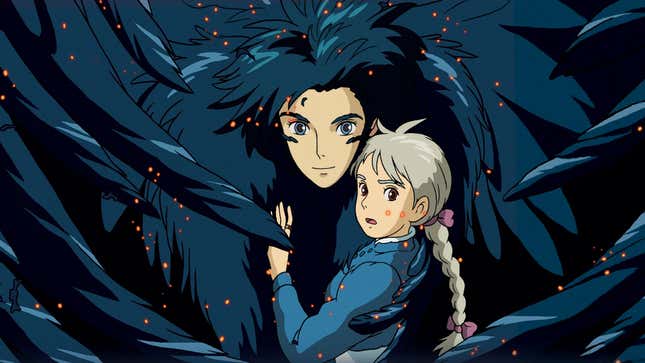
Image: Toho Co., Ltd.
Sophie is a quiet and insecure young woman who, after receiving attention from a handsome wizard named Howl, is cursed by an envious witch. Transformed into a short crone, Sophie volunteers to work as a cleaning lady in Howl’s castle, a steampunk patchwork of wood and metal that loudly lumbers through the countryside. Sophie is kind and hardworking, while Howl is vain and self-absorbed, often throwing tantrums if his hair dye doesn’t turn out right. Despite his flaws, though, he has a good heart. Their differences make the romance that develops between them an enchanting watch.
The castle is also home to other eccentric characters that add a lot of humor, like Calcifer, a fire demon voiced by Billy Crystal, and a cute scarecrow named Turnip Head. Miyazaki ties all of these whimsical elements together with a poignant anti-war message, as you’d expect.
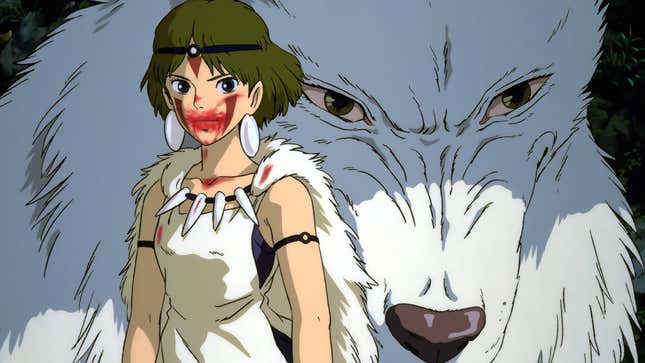
Image: Toho Co., Ltd. / Miramax
Princess Mononoke takes a more biting, intense approach to environmentalism than some of Miyazaki’s other films. It’s a lengthy, sprawling epic about a young man involved in a war between the forest gods and a mining colony. He comes across the iron-willed Mononoke Hime, a young woman raised by the wolf god Moro. A nimble warrior and princess who wields a bone knife and spear, she’s not afraid do whatever it takes to protect the forest gods against the humans who have been systematically destroying their home. Princess Mononoke loves and fights fiercely, making her a bewitching heroine.
Unlike the fanciful creatures of Miyazaki’s other works, the animals in Princess Mononoke are more life-like, majestic, and hauntingly beautiful, and their detailed animation is breathtaking. There’s a towering elk with impressive antlers, a massive wolf, and the Forest Spirit—an awe-inspiring figure resembling both a stag and a mythical Kirin from Japanese folklore. Princess Mononoke does not hold back on the violence and suffering that comes standard with environmental destruction, making this high fantasy epic one of Miyazaki’s darkest and most powerful films.
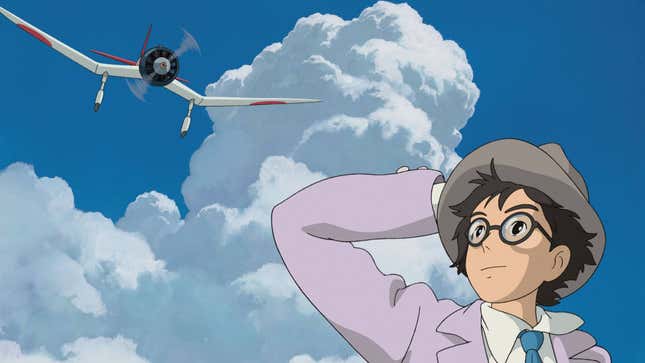
Image: Toho Co., Ltd.
Aside from a continued fascination with flight, The Wind Rises stands apart from Hayao Miyazaki’s other films. There are no mythical realms with fantastical creatures; instead, it’s a sophisticated World War II biopic of Jiro Horikoshi, the Japanese engineer who designed the fighter jets used at Pearl Harbor. Taking some creative liberties with Horikoshi’s life, The Wind Rises explores complex ideas about the price of artistic creation.
Miyazaki contrasts the lovingly crafted details of Horikoshi’s sleek machines and the serene countryside where they were created with the destruction and havoc these machines cause in the world, an internal struggle Horikoshi grapples with throughout the film. These contemplative themes are complemented by Jiro Horikoshi’s touching romance with a woman named Nahako. They meet unexpectedly during an earthquake and never forget one another until they reunite years later. After quickly falling in love, they marry when Nahako is diagnosed with tuberculosis.
The final words on the screen, “The wind rises...We must try to live” are a poetic reminder that although we are constantly swept away by the difficult changes of life, we must adapt to them. The sensitive, humanistic approach to adapting the life of a real person whose passion had severe global repercussions makes The Wind Rises one of Miyazaki’s greatest works.
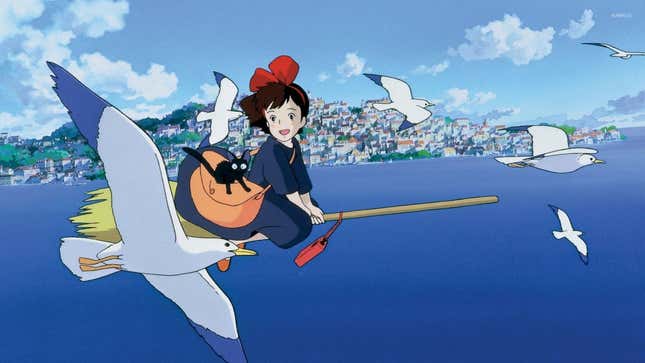
Image: Toei Company / Disney
Kiki is one of Miyazaki’s most endearing heroines: resourceful and kind, curious and outspoken, gregarious and hardworking. At 13, all witches must live independently and discover their “special skill” and Kiki decides to explore flying, which she uses to start a delivery service for a bakery in a quaint coastal town. The gentle charm of Kiki’s Delivery Service lies in the various townsfolk she encounters—like a rambunctious little boy with a huge, sleepy dog, an artist who wants to paint her, and kindly elderly ladies Kiki helps with household chores.
We follow the small, everyday challenges she faces, from hauling packages up tall stairs to dealing with a mischievous gust of wind that makes her lose her first delivery. Kiki’s Delivery Service builds to a thrilling climax in which Kiki must rescue her friend from a burning blimp. It’s a sweet, cozy coming-of-age journey that beautifully captures the uncertainties and heightened emotions of growing up and going out on your own.
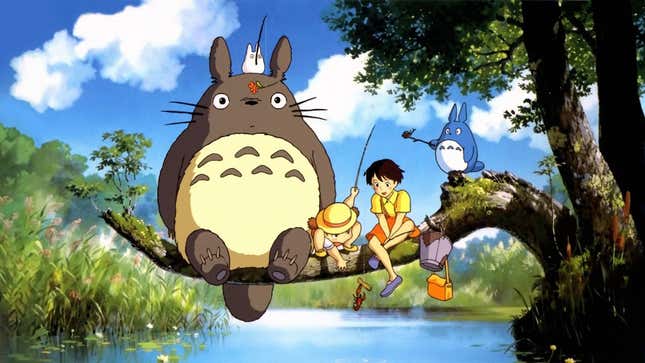
Image: Toho Co., Ltd.
My Neighbor Totoro basks in the purity of childhood wonder. Not much happens in this simple tale about sisters adjusting to their new rural home while their mother recovers in the hospital, but it has so much imagination and heart. The lovely and uncomplicated narrative lets you focus on the magical forest spirit Totoro, a gentle giant with a fluffy, gray body and tall ears.
My Neighbor Totoro is mostly composed of cute, breezy vignettes of Totoro and the sisters engaging in various activities: learning how to use an umbrella, making trees grow out of the ground with a dance, and flying through the air while hanging onto Totoro’s belly, overlooking the entire countryside. There are other enchanting creatures, too: dust bunnies, a giant cat bus with glowing eyes and mice for headlights, and tiny little Totoros that scurry through the forest. There’s a very emotional climax in which the 4-year-old Mei argues with her older sister Satsuki and gets lost, but for the most part My Neighbor Totoro is just a simple story about the magic of being a child.

Image: Toho Co., Ltd. / Disney
Spirited Away has all the elements that make Hayao Miyazaki’s films so unique, but with a darker, Grimms’-fairy-tale-esque edge. 10-year-old Chihiro gets swept away to a dreamlike fantasy world, but not one of excitement and adventure—one of uncertainty and danger. She must face numerous trials to rescue her parents who have been transformed into pigs.
While working at a spirit bathhouse, Chihiro meets surreal creatures that really show off the power of Miyazaki’s designs: evil twin witches, a giant baby, and No-Face, a masked spirit who grows larger with everything and anything he consumes. There’s also the repulsive Stink Spirit, a huge puddle of sludge, and the Susuwatari, small fuzzballs whose entire existence revolves around endlessly putting coal in the bathhouse boiler.
Spirited Away is Hayao Miyazaki’s most mesmerizing film, thanks to its inventive design, sensitive portrayal of childhood fears, and suspenseful story. It’s an absolute classic that transcends the genre.